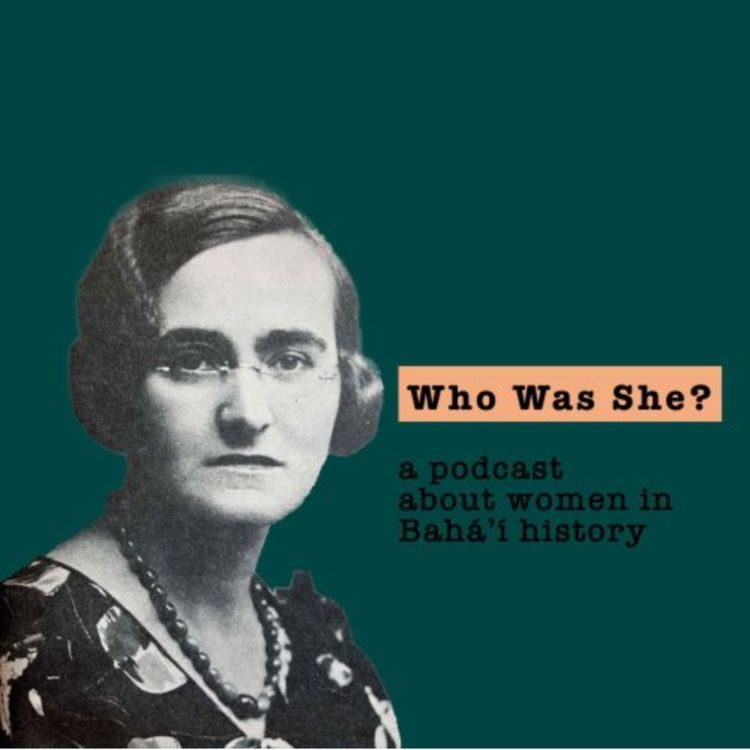Share

Who Was She?
Out of the Abyss
In the season finale, we learn about the several attempts to save Lidia’s life during World War II and last words from her to those who helped her and her family.
TRANSCRIPT:
Welcome to Who was she? Podcast where I, Tara Jabbari share the stories of women throughout Baha’i history. This is the final episode of this season about the life of Lidia Zamenhof, an Esperantist and Baha’i who traveled through three continents to teach languages in effort to bring unity to humankind.
On December 9th, 1938, Lidia arrived back in Poland. It took her some getting used to. She wrote, “The highest skyscraper in Warsaw, of which the city is so proud, because it has seventeen stories, cannot impress me anymore.” She wrote about her travels and despite the many hardships she went through, she only spoke of all the friendships she made. Lidia missed teaching Esperanto but decided to focus on translating Baha’i Writings into Esperanto now that she had the time. She also found out about a friend who died in France and wrote to the family expressing her condolences and also her own feelings about death, “Personally, I believe that…the destruction of the human body does not mean the death of the person. This body, composed of atoms, must disintegrate because everything that is composed must decompose. But the higher part of man, his spirit, does not consist of atoms; it is not a combination of chemical elements and is not subject to the law of decomposition. I believe that our consciousness lives on in ways and conditions which we, still living in the body, cannot imagine, just as the little child in the womb of its mother is incapable of imagining the world it will be coming into and for which is being prepared. Those thoughts are a great consolation for me, whenever physical death places a barrier between myself and those I love…”
Her thoughts and beliefs could bring some comfort to others, certainly to her as the world entered a new war that would ultimately be the cause of her death.
By fall, 1939, the Third Reich invaded Poland which began the second world war. After three weeks of trying to fight them off, Warsaw was conquered. Now they were all under the Nazi rule and Jews had to be distinguished from the rest of the population at all times, which meant that Jews had to wear the Star of David on their sleeves and Jewish businesses and schools were closed with their quarter surrounded by fences and barbed wire to keep away from everyone else.
Learning of what was going on and news about Lidia, in particular, were scarce and hard to distinguish from rumor. In November, 1939 the same year that Martha Root died some Jewish newspapers in the US reported that the Zamenhof family were arrested because Lidia had gone to the United States to spread anti-Nazi propaganda.
Esperantists and Baha’is in America worked together to try and save Lidia’s life. They contacted the Polish Embassy and the US State Department officials in Berlin but officially, they all said they could not take any action as Lidia was not an American citizen.
Letters sent to Lidia’s family were being returned with no forwarding address. But in March, 1940, Stephen Zamenhof, Lidia’s cousin who was in New York when the war broke out was able to learn from family in Russia that the whole family had been arrested after the occupation in Warsaw. Adam, her brother was the first to be arrested at the Jewish Hospital where he had been the Director of the Hospital. Then his wife, Wanda and sister Zofia were arrested. His son, Ludwik was spared due to his illness, possibly of typhus and therefore, left at home. Lidia was also arrested. Ludwik eventually was able to share that Lidia and Zofia were released after several months in Pawiak Prison and found a place to stay in Ogrodowa Street since the Zamenhof home had been destroyed during the bombardment of Warsaw. Adam was sent to Danilwiczowska Prison. Eventually, it was learned that at the end of January, 1940 Dr Adam Zamenhof had been shot and killed with a hundred other intellectuals and professionals.
Meanwhile, an Esperantist, Jozef Arszenik who was taught the Baha’i Faith by Lidia visited her before the Ghetto was sealed off. He offered to hide Lidia in his home on the outskirts of Warsaw. After the war, Mr. Arszenike wrote: “That noble woman refused my offer to save her, saying that I with my family could lose our lives, because whoever hides a Jew perishes along with the Jew who is discovered.” He also wrote that Lidia’s last words to him were, “Do not think of putting yourself in danger; I know that I must die, but I feel it my duty to stay with my people. God grant that our of out sufferings a better world may emerge. I believe in God. I am a Baha’i and will die a Baha’i. Everything is in His hands.” After the war, Mr. Arszenik became a Baha’i and lived till the age of 80.
There are accounts of attempts to save Lidia’s life, one in particular which is what personally inspired me to learn more about Lidia.
In the late 1930s, for Germany, it was clear all signs pointed to a war. A German Baha’i, Fritz Macco and his brother and friends were worried about what that meant for them. As Baha’is, they must obey their government but also as Baha’is, they did not want to fight and did not agree with Germany’s politics The men wrote a letter to the Guardian of the Baha’i Faith, Shoghi Effendi, for guidance. The Guardian reportedly replied that if their desire not to take a life was sincere, God would assist them in attaining it. Fritz and his brother and friends were soon drafted into the army. all of them died in the first week of the war with the exception of twenty-four-year-old Fritz. He was sent to Warsaw as an ambulance driver for the German Army which allowed him to not be in a non-combatant duty. He was puzzled as to why he was spared but when he arrived in Warsaw and found Lidia, he believed he was spared to help save her life. Again, Lidia refused to leave “her people” and though he could not save her life, Fritz would go on to help the Resistance and save many other Jews and Baha’is in occupied land, including his own mother. Sadly In September 1944, Fritz was killed.
By 1942, there was scarce information on Lidia but she was able to send a postcard to a friend in Holland sharing that Zofia and sister-in-law, Wanda are working as doctors in the Ghetto. Although she never wrote it down, it was probable that Lidia was teaching others English. This was against the law as English was considered the enemy's language under-occupied Poland but it gave people hope. But in July 1942, there was the order that all the Jews of the Warsaw Ghetto were to be “deported to the east,” to a camp called, Treblinka.
While Wanda and her son Ludwik were able to escape and survive outside the Ghetto during the deposition, Lidia and Zofia were not able to. They were taken 120 kilometers from Warsaw to Treblinka. The death camp was about fifty acres and surrounded by antitank barriers and barbed wire with watchtowers in each corner. There were gas chambers and burial pits where the bodies were disposed of originally by lime then later by burning on large iron racks. Eventually, Nazis became worried that the mass graves might be discovered so they exhumed and burned them. It is calculated that one million, two hundred Jews died at Treblinka including Lidia and her sister. The author of Lidia’s biography Wendy Heller writes, “Among the ashes in the ground at Treblinka are those of Lidia Zamenhof.” She was thirty-eight years old.
After the war, it was discovered that miraculously, the Jewish cemetery had not been destroyed and Ludwik Zamenhof’s tomb still stood. There eventually would be a plaque set in place on Klara Zamenhof’s grave with the names of Lidia and Zofia, that reads “Murdered in the year 1942. Let the memory of them last forever.”
There was a memorial service held in honor of Lidia by the Baha’is of the United States and Canada on the week of October 25th, 1946. Lidia refused to allow others to endanger themselves in order to save her, she felt a duty to be with her family and the Jewish community. Lidia never hid away from trying to find meaning in the world. She found love in faith and language that she believed would unite everyone. She believed what truly mattered was how someone faced a challenge. I leave you with Lidia’s own words, “behind the densest clouds the sun is shining, that the Most Great Peace will come.’ ‘Whoever can still find in his heart a single ray of faith, as delicate and any as a spider’s thread, will not perish in the abyss, but even if all the powers of this world rise to struggle against him to push him down, even in the fall itself he will stop, and by this ray, as why the biblical ladder, even out of the abyss will ascend to heaven.’
This has been Who was she? Podcast, follow us on our Instagram, Facebook and Pinterest @whowasshe podcast. And please, rate and subscribe wherever you listen to this podcast. Logo was designed by Angela Musacchio. Music was composed and performed by Sam Redd. I am your host, Tara Jabbari.
More episodes
View all episodes

8. Bonus episode! BTS on Hazel Scott
27:39||Season 3, Ep. 8A conversation with host Tara and her friend, Angie. Learn how this podcast season came about, the challenges, the creative process, the people who helped make this season, and hear a sneak preview of who the next season will be about!
7. Moved To Her Feet
10:59||Season 3, Ep. 7Partial Transcript: Welcome, I am your host, Tara Jabbari. Who was she? Podcast will focus on the stories of women throughout history that were active in the Baha’i Faith. This season is about Hazel Scott, a talented musician and activist. She had evolved in her faith. Having been introduced to the Baha’i Faith by her good friend and famous jazz artist, Dizzy Gillespie, she was interested in learning more. She was particularly intrigued by “progressive revelation.” This is the belief that Manifestations of God represent stages in the spiritual evolution of civilization. These Manifestations include Abraham, Moses, Krishna, Buddha, Zoroaster, Christ and Muhammad. Or as she explained, “Whenever man has been ready to absorb more knowledge, God has revealed it.” Baha’u’llah is the Manifestation of the Baha’i Faith.Hazel fought nonstop for what was right, she achieved many firsts and her talent was truly one of a kind. In one of the last interviews she ever did, she was asked what is the most important part in her life. Hazel replied, “The important part? When I have been able to transmit that which I have been singularly gifted with…to move an audience to their feet.” I hope you enjoyed learning about Hazel Scott, I certainly did and hope you are inspired and moved to your feet just like she would want.
6. Hazel's Paris
09:16||Season 3, Ep. 6Patrial Transcript: Recovering from the dissolution of her marriage as well as a second suicide attempt, Hazel was determined to move on with her life in Paris. The French film industry was interested in Hazel. Now that she felt she had earned more maturity and life experience, she was comfortable actually acting in a role. So she went on set for Le Desordre et la Nuit (Disorder of the Night) where she played a supporting role as a dancer. It was the first time she was playing someone other than herself on screen. Her son shared that after the first day of filming, Hazel came home and announced, “Your Mother does not speak french!” According to Skipper, he knew there was trouble whenever she began a sentence with “your mother.” It turned out that her accent needed work, not necessarily her language skills so the studio got her a french dialect coach. That same day, they got the news that Harry Cohn, the president of Columbia Pictures had died. She explained to the cast and crew the whole story of Cohn and his promise that she would never make another movie until the day he died. And now, years after his promise, he died and she was on a set filming. It would become one of her favorite stories to tell, no longer would Cohn threaten her career on the big screen. Hazel went on to film a couple of other french films. Very nearly including Paris Blues with Sidney Poitier & Paul Newman but ultimately the part went to another. She was still synonymous with being a musician even on the big screen. Hazel said, “Once you played the priest, you can never play the gangster…Everybody just wants me to come on and sing. And I can do so much more than that.”
5. A Great Act of Faith
07:29||Season 3, Ep. 5Partial transcript: Between 1950 to 1952, Hazel had nearly lost her reputation and her life. The Red Scare and the HUAC hearings put a toll on her career. The growing attention on her marriage, the loss of work in the United States, and the constant public attention caused Hazel to have a mental breakdown and attempt suicide. Thankfully by May 1952, Hazel was doing better through the best medical care her husband could find her. She was performing and showing the world that nothing could stop Hazel Scott and her immense talent. Paul E. Magliore, the President of Haiti invited Hazel to attend the 150th anniversary of Haiti’s independence. Hazel gladly accepted as she was an anti-colonialist and felt a kinship with the Haiti people. When years later, Trinidad, her birth country became a free country, her son remembered Hazel went screaming through the house, “We’re free! We’re free!” In 1955, Hazel wanted to go back to Paris and Adam encouraged the move but would not join her. They already were drifting apart from their marriage and now, they were physically apart. They hadn’t been happy for a while. Adam suggested an open marriage but it was not necessarily to save their marriage. He wanted to keep his family man image for his political look with the freedom of spending time with other women. Hazel did not agree to the proposal. She said, “I couldn’t face a marriage of convenience, especially if it was at my inconvenience.” Deeply unhappy with the state of her marriage, she decided faith would be the only thing that could help.Learn and listen more:https://shows.acast.com/who-was-she-podcastAlso available on:https://podcasts.apple.com/us/podcast/who-was-she/id1548368026https://www.amazon.com/dp/B08JJS5J2T/ref=cm_sw_em_r_mt_dp_H6paGbTR63EK9https://open.spotify.com/show/78a4pv6tYgad4C0mEftAgBYou can also find more information on our social media:http://instagram.com/whowasshepodcasthttps://www.facebook.com/whowasshepodcasthttps://www.pinterest.com/whowasshepodcast
4. They Saw Red
10:23||Season 3, Ep. 4Partial Transcript: After Hazel had married Congressman, Adam Clayton Powell Jr. her music career changed from late-night jazz to a more conservative, classical approach which proved to be very successful. Hazel said goodbye to 1945 and to her mother Alma but 1946 brought new life. On July 17th, Hazel gave birth to a son, Adam Clayton Powell The Third, or affectionately called, Skipper. She said, “My greatest thrill was the first time I saw Skipper.” Adam and Hazel were both very busy but they made sure they would be home on weekends. During the week, a housekeeper cared for their son. Skipper, later on, said, “They decided to try to have as normal a life as possible. (Dad) would be in Washington during the week at least January through May, and (Mom) would be traveling a lot but on Saturday and Sunday, we were going to be a family. And so wherever they were, the deal was they would have to get back to New York by Friday night.”The Powells were famous, being a celebrated and high-profile black power couple. However, behind closed doors, it was not easy, Hazel admitted, “We fought bitterly but loved each other deeply.” She confessed that she did think of ending her marriage in the first year. The constant pressure of everyday life, their bustling careers, and their public persona along with the death of her mother and a new baby were all so much for Hazel. She tried to repress her emotions which would eventually end with almost dire consequences. Along with all of her responsibilities and attention, she still dealt with constant racism. Learn and listen more:https://shows.acast.com/who-was-she-podcastAlso available on:https://podcasts.apple.com/us/podcast/who-was-she/id1548368026https://www.amazon.com/dp/B08JJS5J2T/ref=cm_sw_em_r_mt_dp_H6paGbTR63EK9https://open.spotify.com/show/78a4pv6tYgad4C0mEftAgBYou can also find more information on our social media:http://instagram.com/whowasshepodcasthttps://www.facebook.com/whowasshepodcasthttps://www.pinterest.com/whowasshepodcast
3. Adam Clayton Powell Jr .
10:25||Season 3, Ep. 3Partial Transcript: By the 1940s, Hazel Scott was touring the country, known for her unique style of piano and singing, combining classical music with jazz. Her short film career was now cursed by Columbia Picture’s head Harry Cohn. “I have always been a very strong feminine creature,” Hazel said, “and to subdue me a very, very strong masculine creature is required.” Enter Adam Clayton Powell, Jr. He was born on Nov 29th, 1908. When his family moved from Connecticut to Harlem, he had his first brush with racism. The Powell family were mostly light-skinned of African, European and Native American ancestry. His lighter complexion did often lead to bullying, with one block of black children and another block of Italian and Irish children demanding to know if he was white or black. In order to survive, Adam became what people needed him to be, black in black crowds and white in white crowds. This chameleon-like adjustment was the beginning of his natural charisma that would make him a successful politician. Learn and listen more:https://shows.acast.com/who-was-she-podcastAlso available on:https://podcasts.apple.com/us/podcast/who-was-she/id1548368026https://www.amazon.com/dp/B08JJS5J2T/ref=cm_sw_em_r_mt_dp_H6paGbTR63EK9https://open.spotify.com/show/78a4pv6tYgad4C0mEftAgBYou can also find more information on our social media:http://instagram.com/whowasshepodcasthttps://www.facebook.com/whowasshepodcasthttps://www.pinterest.com/whowasshepodcast
2. The Darling of Cafe Society
10:46||Season 3, Ep. 2Welcome to Who was she? Podcast. I am your host, Tara Jabbari. After a decade working in documentaries, marketing and all things digital media, I found that podcasting is a strong medium to share stories and after years of producing for others, I decided to start my own biographical podcast. Who was she? Podcast will focus on the stories of women throughout history that were active in the Baha’i Faith. This season is about an incredible and often overlooked talented musician, and activist, Hazel Scott.Learn and listen more:https://shows.acast.com/who-was-she-podcastAlso available on:https://podcasts.apple.com/us/podcast/who-was-she/id1548368026https://www.amazon.com/dp/B08JJS5J2T/ref=cm_sw_em_r_mt_dp_H6paGbTR63EK9https://open.spotify.com/show/78a4pv6tYgad4C0mEftAgBYou can also find more information on our social media:http://instagram.com/whowasshepodcasthttps://www.facebook.com/whowasshepodcasthttps://www.pinterest.com/whowasshepodcast
1. Presence of a Genius
08:16||Season 3, Ep. 1Welcome to Who was she? Podcast. I am your host, Tara Jabbari. After a decade working in documentaries, marketing and all things digital media, I found that podcasting is a strong medium to share stories and after years of producing for others, I decided to start my own biographical podcast. Who was she? Podcast will focus on the stories of women throughout history that were active in the Baha’i Faith. This season is about an incredible and often overlooked talented musician, and activist, Hazel Scott.Learn and listen more:https://shows.acast.com/who-was-she-podcastAlso available on:https://podcasts.apple.com/us/podcast/who-was-she/id1548368026https://www.amazon.com/dp/B08JJS5J2T/ref=cm_sw_em_r_mt_dp_H6paGbTR63EK9https://open.spotify.com/show/78a4pv6tYgad4C0mEftAgBYou can also find more information on our social media:http://instagram.com/whowasshepodcasthttps://www.facebook.com/whowasshepodcasthttps://www.pinterest.com/whowasshepodcast
Trailer for Season 3: Hazel Scott
03:31||Season 3, Ep. 0Welcome to Who was she? Podcast. I am your host, Tara Jabbari. After a decade working in documentaries, marketing and all things digital media, I found that podcasting is a strong medium to share stories. After years of producing for others, I decided to start my own biographical podcast. Who was she? Will focus on the life of a woman throughout Baha’i history. The third season is about Hazel Scott.Transcript: Born in 1920 and originally from Trinidad, Hazel was raised in Harlem and when she was only 8 years old, she was accepted as a pianist protegee at the prestigious Julliard School. Her mother was also a musician and artists over the years became Hazel’s extended family. For instance, Pianist, Art Tatum was a father figure, saxophonist, Lester Young an uncle and singer, Billie Holiday was a big sister to Hazel to name a few. When she was a teenager, she started singing and playing across Manhatten. She became a regular at a new club, Cafe Society. Unlike other clubs at the time where black musicians played primarily for white patrons, this club was based on equality and diversity which made it like no other club in New York City at the time. When she toured, she was adamant to only play in places that did not segregate the audience. This limited her venues but she kept her stance. She married Adam Clayton Powell Jr, an activist and politician which heightened both their fame. This season, you will hear how she was blacklisted from working in the United States because of the McCarthy trials, cursed from working in Hollywood, and how her search for faith helped her fight depression and find the strength to be strong in the face of racism. So please subscribe and learn about this amazing woman who used her unique musical abilities to entertain and educate the world about racial equality. You can also found more information on our social media: http://instagram.com/whowasshepodcasthttps://www.facebook.com/whowasshepodcasthttps://www.pinterest.com/whowasshepodcast